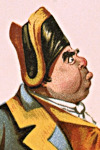
A few weeks ago, I introduced the Washington Asylum out on Reservation 13, and how it looked from the outside. It was, in the telling of George Alfred Townsend (aka Gath) a pretty “smart” building to behold.
Gath first describes how to get there:
To visit the Poor-House one must have a “permit” from the mayor, physician, or a poor commissioner. [That’s not a reflection of the commissioner’s talents, rather there were three commissioners of the asylum, who were known as the “poor commissioners”] Provided with this, he will follow out Pennsylvani Aavnue [sic] over Capitol Hill, ntil nearly at the brink of the Anacostia or Eastern Branch, when by the oblique Avenue called “Georgia”
he will bass to his right the Congressional burying ground, and arriving at the powder magazine in front, draw up at the alms-house gate, a mile and a quarter from the palace of Congress.
We will gloss over the fact that, at this time, D.C. did not have a Mayor, rather a governor, and hope that what he writes about the inside is more accurate. He starts with a long-winded exegesis on the surroundings, the cedars that “give a stubby look of grief to the region around the poorhouse,” the plains now emptied of the hospitals and now populated only by funeral processions, headed either to Congressional Cemetery or the Potter’s Field. He finally introduces us to the intendent of the Asylum, a Joseph F. Hodgson, whom he called “a very cheerful and practical-looking “Bumble.” Presumably, he is referring only to Mr. Bumble’s occupation, not his abilities.

After a few more pages of harrumphing, Gath finally describes the interior:
The Washington Poor-house seems to be well arranged, except in one respect: under the same roof, divided only by a partition and a corridor, the vicious are lodged for punishment and the unfortunate for refuge
We passed through a part of the building where, amongst old, toothless women, semi-imbecile girls – the relicts of error, the heirs of affliction – three babies of one mother were in charge of a strong, rosy Irish nurse. Two of them, twins, were in her lap, and a third upon the floor, hallooing for joy. Such noble specimens of childhood we had never seen; heads like Caesar’s eyes bright as the depths of wells into which one laughs and receives his laughter back, and complexions and carriage of high birth. The woman was suckling them all, and all crowded alternately, so that they made the bare floors and walls light up with pictures. A few yards off, though out of hearing, were the thick forms of criminals, drunkards, wantons, and vagrants, seen through the iron bars of their wickets, raising the croon and song of an idle din, drumming on the floor, or moving to and fro restlessly. Beneath this part of the Almshouse were cells were bad cases were locked up. The association of the poor and the wicked affected us painfully.
After visiting the syphilitic wards and the graves of the Almshouse dead, Gath calls it a day.
The Asylum is, of course, now long closed, but its closure does not seem to have generated any press whatsoever, much as there are no pictures of it. It seems that people wanted to ignore this institution as much as possible, so we can thank Royall and Gath for their attempts to remember how the poor were treated in the 19th century.
